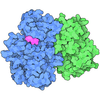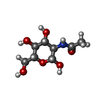+ データを開く
データを開く
- 基本情報
基本情報
| 登録情報 | データベース: PDB / ID: 9ipb | ||||||||||||||||||||||||
|---|---|---|---|---|---|---|---|---|---|---|---|---|---|---|---|---|---|---|---|---|---|---|---|---|---|
| タイトル | Local refinement structure of sEGFR and 528 Fv (from LH-type bispecific diabody Ex3) complex | ||||||||||||||||||||||||
 要素 要素 |
| ||||||||||||||||||||||||
 キーワード キーワード | ANTITUMOR PROTEIN/IMMUNE SYSTEM / bispecific antibody / diabody / EGFR / LH / Ex3 / 528 / local refinement / ANTITUMOR PROTEIN / ANTITUMOR PROTEIN-IMMUNE SYSTEM complex | ||||||||||||||||||||||||
| 機能・相同性 |  機能・相同性情報 機能・相同性情報multivesicular body, internal vesicle lumen / negative regulation of cardiocyte differentiation / Shc-EGFR complex / positive regulation of protein kinase C signaling / Inhibition of Signaling by Overexpressed EGFR / epidermal growth factor receptor activity / EGFR interacts with phospholipase C-gamma / regulation of peptidyl-tyrosine phosphorylation / epidermal growth factor binding / response to UV-A ...multivesicular body, internal vesicle lumen / negative regulation of cardiocyte differentiation / Shc-EGFR complex / positive regulation of protein kinase C signaling / Inhibition of Signaling by Overexpressed EGFR / epidermal growth factor receptor activity / EGFR interacts with phospholipase C-gamma / regulation of peptidyl-tyrosine phosphorylation / epidermal growth factor binding / response to UV-A / PLCG1 events in ERBB2 signaling / ERBB2-EGFR signaling pathway / morphogenesis of an epithelial fold / PTK6 promotes HIF1A stabilization / ERBB2 Activates PTK6 Signaling / digestive tract morphogenesis / Signaling by EGFR / intracellular vesicle / negative regulation of epidermal growth factor receptor signaling pathway / eyelid development in camera-type eye / cerebral cortex cell migration / protein insertion into membrane / ERBB2 Regulates Cell Motility / protein tyrosine kinase activator activity / Respiratory syncytial virus (RSV) attachment and entry / Signaling by ERBB4 / PI3K events in ERBB2 signaling / positive regulation of phosphorylation / positive regulation of peptidyl-serine phosphorylation / Estrogen-dependent nuclear events downstream of ESR-membrane signaling / hair follicle development / MAP kinase kinase kinase activity / GAB1 signalosome / positive regulation of G1/S transition of mitotic cell cycle / embryonic placenta development / salivary gland morphogenesis / Signaling by ERBB2 / TFAP2 (AP-2) family regulates transcription of growth factors and their receptors / GRB2 events in EGFR signaling / SHC1 events in EGFR signaling / transmembrane receptor protein tyrosine kinase activity / EGFR Transactivation by Gastrin / GRB2 events in ERBB2 signaling / ossification / SHC1 events in ERBB2 signaling / basal plasma membrane / positive regulation of DNA repair / cellular response to epidermal growth factor stimulus / positive regulation of DNA replication / epithelial cell proliferation / positive regulation of epithelial cell proliferation / Signal transduction by L1 / positive regulation of protein localization to plasma membrane / NOTCH3 Activation and Transmission of Signal to the Nucleus / cellular response to amino acid stimulus / phosphatidylinositol 3-kinase/protein kinase B signal transduction / cellular response to estradiol stimulus / EGFR downregulation / clathrin-coated endocytic vesicle membrane / Signaling by ERBB2 TMD/JMD mutants / Constitutive Signaling by EGFRvIII / cell-cell adhesion / receptor protein-tyrosine kinase / Signaling by ERBB2 ECD mutants / negative regulation of protein catabolic process / Signaling by ERBB2 KD Mutants / positive regulation of miRNA transcription / kinase binding / ruffle membrane / Downregulation of ERBB2 signaling / epidermal growth factor receptor signaling pathway / positive regulation of protein phosphorylation / positive regulation of fibroblast proliferation / cell morphogenesis / neuron differentiation / HCMV Early Events / Constitutive Signaling by Aberrant PI3K in Cancer / actin filament binding / cell junction / transmembrane signaling receptor activity / positive regulation of canonical Wnt signaling pathway / Cargo recognition for clathrin-mediated endocytosis / PIP3 activates AKT signaling / Constitutive Signaling by Ligand-Responsive EGFR Cancer Variants / Clathrin-mediated endocytosis / virus receptor activity / ATPase binding / PI5P, PP2A and IER3 Regulate PI3K/AKT Signaling / RAF/MAP kinase cascade / positive regulation of cell growth / double-stranded DNA binding / protein tyrosine kinase activity / early endosome membrane / protein phosphatase binding / nuclear membrane / basolateral plasma membrane / learning or memory / cell surface receptor signaling pathway / Extra-nuclear estrogen signaling / positive regulation of ERK1 and ERK2 cascade 類似検索 - 分子機能 | ||||||||||||||||||||||||
| 生物種 |  Homo sapiens (ヒト) Homo sapiens (ヒト)synthetic construct (人工物) | ||||||||||||||||||||||||
| 手法 | 電子顕微鏡法 / 単粒子再構成法 / クライオ電子顕微鏡法 / 解像度: 2.93 Å | ||||||||||||||||||||||||
 データ登録者 データ登録者 | Sato, K. / Uehara, S. / Tsugita, A. / Matsui, T. / Asano, R. / Makabe, K. / Yokoyama, T. / Tanaka, Y. | ||||||||||||||||||||||||
| 資金援助 |  日本, 1件 日本, 1件
| ||||||||||||||||||||||||
 引用 引用 |  ジャーナル: Cell Rep / 年: 2025 ジャーナル: Cell Rep / 年: 2025タイトル: Bispecific antibody-antigen complex structures reveal activity enhancement by domain rearrangement. 著者: Kyohei Sato / Shiro Uehara / Atsushi Tsugita / Mayuka Ishii / Shieru Ishiyama / Atsushi Maejima / Ishin Nakahara / Misae Nazuka / Takashi Matsui / Gatsogiannis Christos / Takeshi Yokoyama / ...著者: Kyohei Sato / Shiro Uehara / Atsushi Tsugita / Mayuka Ishii / Shieru Ishiyama / Atsushi Maejima / Ishin Nakahara / Misae Nazuka / Takashi Matsui / Gatsogiannis Christos / Takeshi Yokoyama / Izumi Kumagai / Koki Makabe / Ryutaro Asano / Yoshikazu Tanaka /   要旨: Bispecific antibodies (BsAbs) have been developed as anti-cancer drugs that accumulate activated T cells on cancer cells by bridging the antigens present in each cell. Ex3 is a diabody-type BsAb ...Bispecific antibodies (BsAbs) have been developed as anti-cancer drugs that accumulate activated T cells on cancer cells by bridging the antigens present in each cell. Ex3 is a diabody-type BsAb composed of an anti-epidermal growth factor receptor (EGFR) antibody and an anti-CD3 antibody. In the design of Ex3, the LH-type domain order (Ex3LH) is shown to have more than 100-fold greater anti-cancer activity than the HL-type domain order (Ex3HL). To understand this phenomenon of activity enhancement by domain-order rearrangement, we report here cryoelectron microscopy (cryo-EM) structures of both Ex3HL and Ex3LH in complex with EGFR and CD3. A structural comparison of the HL and LH types reveals that the domain rearrangement leads to drastic structural changes and that the avoidance of steric hindrance by a favorable bridging angle on the cell surface is the fundamental mechanism for this activity enhancement. | ||||||||||||||||||||||||
| 履歴 |
|
- 構造の表示
構造の表示
| 構造ビューア | 分子:  Molmil Molmil Jmol/JSmol Jmol/JSmol |
|---|
- ダウンロードとリンク
ダウンロードとリンク
- ダウンロード
ダウンロード
| PDBx/mmCIF形式 |  9ipb.cif.gz 9ipb.cif.gz | 166.3 KB | 表示 |  PDBx/mmCIF形式 PDBx/mmCIF形式 |
|---|---|---|---|---|
| PDB形式 |  pdb9ipb.ent.gz pdb9ipb.ent.gz | 127.4 KB | 表示 |  PDB形式 PDB形式 |
| PDBx/mmJSON形式 |  9ipb.json.gz 9ipb.json.gz | ツリー表示 |  PDBx/mmJSON形式 PDBx/mmJSON形式 | |
| その他 |  その他のダウンロード その他のダウンロード |
-検証レポート
| アーカイブディレクトリ |  https://data.pdbj.org/pub/pdb/validation_reports/ip/9ipb https://data.pdbj.org/pub/pdb/validation_reports/ip/9ipb ftp://data.pdbj.org/pub/pdb/validation_reports/ip/9ipb ftp://data.pdbj.org/pub/pdb/validation_reports/ip/9ipb | HTTPS FTP |
|---|
-関連構造データ
| 関連構造データ |  60768MC  9ip7C  9ip8C  9ip9C  9ipaC  9ipcC  9ipdC  9ipeC M: このデータのモデリングに利用したマップデータ C: 同じ文献を引用 ( |
|---|---|
| 類似構造データ | 類似検索 - 機能・相同性  F&H 検索 F&H 検索 |
- リンク
リンク
- 集合体
集合体
| 登録構造単位 | 
|
|---|---|
| 1 |
|
- 要素
要素
| #1: タンパク質 | 分子量: 69496.062 Da / 分子数: 1 / 由来タイプ: 組換発現 / 由来: (組換発現)  Homo sapiens (ヒト) / 遺伝子: EGFR, ERBB, ERBB1, HER1 Homo sapiens (ヒト) / 遺伝子: EGFR, ERBB, ERBB1, HER1発現宿主:  参照: UniProt: P00533, receptor protein-tyrosine kinase | ||||||
|---|---|---|---|---|---|---|---|
| #2: 抗体 | 分子量: 26651.629 Da / 分子数: 1 / Mutation: Y52W / 由来タイプ: 組換発現 / 由来: (組換発現) synthetic construct (人工物) / 発現宿主:  Brevibacillus choshinensis (バクテリア) Brevibacillus choshinensis (バクテリア) | ||||||
| #3: 多糖 | | #4: 糖 | 研究の焦点であるリガンドがあるか | N | Has protein modification | Y | |
-実験情報
-実験
| 実験 | 手法: 電子顕微鏡法 |
|---|---|
| EM実験 | 試料の集合状態: PARTICLE / 3次元再構成法: 単粒子再構成法 |
- 試料調製
試料調製
| 構成要素 |
| ||||||||||||||||||||||||
|---|---|---|---|---|---|---|---|---|---|---|---|---|---|---|---|---|---|---|---|---|---|---|---|---|---|
| 由来(天然) |
| ||||||||||||||||||||||||
| 由来(組換発現) |
| ||||||||||||||||||||||||
| 緩衝液 | pH: 7.4 | ||||||||||||||||||||||||
| 試料 | 包埋: NO / シャドウイング: NO / 染色: NO / 凍結: YES | ||||||||||||||||||||||||
| 急速凍結 | 凍結剤: ETHANE |
- 電子顕微鏡撮影
電子顕微鏡撮影
| 顕微鏡 | モデル: JEOL CRYO ARM 300 |
|---|---|
| 電子銃 | 電子線源:  FIELD EMISSION GUN / 加速電圧: 300 kV / 照射モード: FLOOD BEAM FIELD EMISSION GUN / 加速電圧: 300 kV / 照射モード: FLOOD BEAM |
| 電子レンズ | モード: BRIGHT FIELD / 最大 デフォーカス(公称値): 2400 nm / 最小 デフォーカス(公称値): 900 nm |
| 撮影 | 電子線照射量: 60 e/Å2 / フィルム・検出器のモデル: GATAN K3 (6k x 4k) |
- 解析
解析
| EMソフトウェア | 名称: PHENIX / カテゴリ: モデル精密化 |
|---|---|
| CTF補正 | タイプ: PHASE FLIPPING AND AMPLITUDE CORRECTION |
| 3次元再構成 | 解像度: 2.93 Å / 解像度の算出法: FSC 0.143 CUT-OFF / 粒子像の数: 1085217 / 対称性のタイプ: POINT |
| 精密化 | 最高解像度: 2.93 Å 立体化学のターゲット値: REAL-SPACE (WEIGHTED MAP SUM AT ATOM CENTERS) |
 ムービー
ムービー コントローラー
コントローラー










 PDBj
PDBj
















